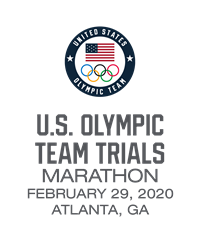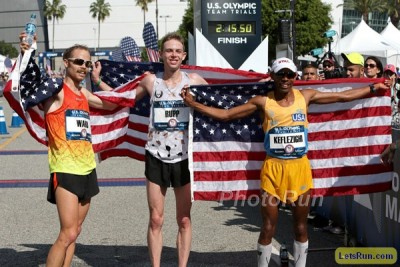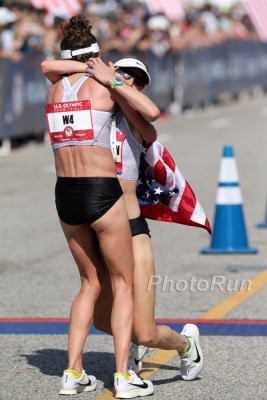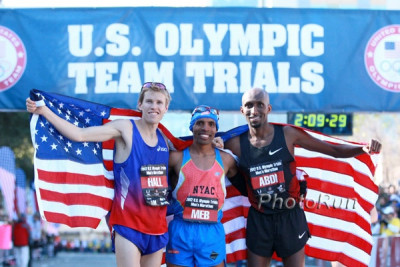The Olympic Marathon Trials Are (Still) In Jeopardy — Here’s What USATF & the IAAF Can Do to Fix It
By LetsRun.com
May 14, 2019
The significance of the greatest marathon in the United States is in jeopardy.
Held every four years, the US Olympic Marathon Trials represent all that is great about our sport. All of America’s best gather in one place on one day to race and try to reach the pinnacle of our sport — the Olympic Games. Finish in the top three and you go to the Olympics. Finish outside of the top three and your Olympic dream waits another four years.
The simplicity and cruelty of the Olympic Marathon Trials is why it is the pre-eminent marathon in the United States. Boston, Chicago, and New York may be World Marathon Majors, but when it comes to the hearts and minds of the running public, the Olympic Marathon Trials are #1. Millions of runners dream of the Olympics, thousands throughout America train for the Trials, hundreds qualify for it, and then only the top three make the team.
The Olympic dream spreads throughout America because of the Trials. It’s the foundation of elite distance running in the United States. There’s a reason the Marathon Trials are the only American marathon broadcast live on network TV: it’s the most compelling marathon in the United States.
Now all of that is in jeopardy unless the IAAF (the world track governing body) and USATF (USA Track & Field) make some common sense changes to the Olympic qualifying procedures.
Long story short, last year Atlanta was awarded the 2020 Olympic Trials, which will be contested on February 29, 2020. After Atlanta designed a hilly, difficult course and agreed to spend over $1 million to host the Trials, the IAAF announced it was changing its Olympic qualifying procedures with the goal of promoting riveting head-to-head competition. While the details of these changes are a little complicated, there is no doubt America will still send three runners of both genders to the Olympics in the marathon under the new system. Ironically, however, the unintended result may be that it is far from guaranteed that someone who finishes in the top three in Atlanta will make the Olympic team, because of the way USATF is responding to these changes. So instead of promoting head-to-head competition, the IAAF may be killing it off.
That is terrible and needs to change. Furthermore, it’s contrary to the IAAF’s stated goals of its new ranking system. Here’s what IAAF president Sebastian Coe said when the IAAF announced the world rankings in 2017:
“For the first time in the sport’s history, athletes, media and fans will have a clear understanding of the hierarchy of competitions from national through to area and up to global events, allowing them to follow a logical season-long path to the pinnacle of athletics’ top two competitions.”
Under the old Trials format, the hierarchy and logical path was very easy to understand for US fans, Olympic Trials then Olympics. American fans had a clear understanding of how it worked. The new format could feature an illogical path (top three don’t automatically make the Olympics), making it difficult for fans to understand.
Furthermore, the changes to the Trials would severely dampen the mystique and dream of the Trials, and could eventually lead to the extinction of the Trials. A simple solution is for the IAAF to say that any country that holds a trials with 10 or more competitors at sub-2:15 for the men and sub-2:33 for the women (within 3:30 of the auto qualifying standard) will result in the top three finishers at those trials being given the auto standard if they don’t already have it.
That is fair, universal, and it would protect the greatness of the Olympic Marathon Trials.
USATF may be meeting with the IAAF to try to work out a solution, but we don’t think either party understands how central to the distance running community the Olympic Marathon Trials are in America. So they could use some encouragement. We want others in the running community to pick up this own issue and publish their own articles.
Please, take 30 seconds to tweet, post, and share about this issue with the tags @USATF, @iaaforg, @TeamUSA, @NBCSports, and #savethetrials. We couldn’t care less if you share this article — we just want awareness to the issue in general. Write your own article and we’ll reshare it.
If you’d like the details on how we got to this point, keep reading below.
MB: Help save the US Olympic Marathon Trials – A call to action
Update on 5/15/19: We’ve received the following statement from Rich Kenah, the Executive Director of Atlanta Track Club as well as 1997 bronze medallist and 2000 US Olympian:
“I applaud the IAAF and its attempt to create a meaningful world ranking system. A well thought out commercial strategy built on such rankings and void of politics is a long time coming. Unfortunately, the timing of the announcement of these rankings and the lack of regard for the US Olympic Trials system will potentially gut a collective effort in this country to promote the sport, the Olympic Games and, most importantly, the athletes chasing a spot in the 2020 Tokyo Olympics. A Trials competition that starts with every athlete on the line chasing an Olympic birth through a simple 1-2-3 finish is universally understood and is unmatched in excitement and suspense. If media, spectators and the general public need a compass to navigate and understand what they are looking at, then we have all lost the race before it even begins.
“Atlanta Track Club stands ready to work with USA Track & Field, the USOC, other national federations, sponsors and broadcasters to find a solution for the Tokyo qualifying period that allows the IAAF to build its commercial interests while respecting the needs of all constituent groups, the most important group being the athletes who are so often underrepresented in these types of conversations.
“The leaders of this, the greatest Olympic sport, expect athletes to rise to the occasion when it matters most. Will they do the same and find a solution here? I hope so as a generation of Olympic hopefuls are depending on it. “
***************
Where things stand
Spring marathon season is over. The 2020 US Olympic Marathon Trials are nine months away. It’s been more than two months since the IAAF changed its Olympic qualifying process in the midst of the qualifying window. And we still don’t know how USATF will be selecting its marathon team for the 2020 Olympic Games.
Whatever USATF decides will have a major impact on the 160 men and 302 women currently qualified for the Trials. Right now, USATF is still deciding how it will pick its team, and the final decision may not come for another two months — at which point, many athletes will be well into their fall marathon preparations.
“The USATF LDR committee continues work on 2020 Olympic Qualifying procedures for the men’s & women’s marathons, and we anticipate they’ll be final before the Toyota USATF Outdoor Championships (July 25-28),” USATF managing director of communications Susan Hazzard wrote to LetsRun in an email last week.
This is a critical moment for USATF and for the athletes it serves. Make the right choice, and February’s Marathon Trials in Atlanta have a chance to be exactly what they should be: the fairest and most exciting way to pick an Olympic team. Make the wrong choice, and the Olympic dreams of hundreds of athletes could die before a gun is fired.
How we got here
In March, the IAAF announced the qualification system for the 2020 Olympics, a deviation from years past. In 2016, the entry standards for the Olympic marathon were eminently attainable: 2:19:00 for the men and 2:45:00 for the women. The Olympic standards were such that anyone who entered the US Trials could reasonably expect to hit them, and the best part of the Trials — top three make the team — was never in jeopardy.
The new Olympic qualification system is different. Under pressure from the IOC to limit the number of athletes in track & field, the IAAF has significantly trimmed the size of the Olympic marathons. There were 155 men and 156 women in the 2016 Olympic marathons; the IAAF is aiming for 80 men and 80 women in 2020. In addition, the IAAF has introduced a new world ranking system and wants to make use of it in the Olympic qualifying process.
The result? The automatic Olympic entry standards of 2:11:30 (men) and 2:29:30 (women) got significantly harder (athletes can also qualify by finishing top 10 in a World Marathon Major or top 5 in an IAAF Gold Label Marathon in 2019 or 2020).
Should USATF stick to the model it has used in past Olympic Trials and USATF championships — top three finishers with the Olympic standard make the team — the consequences could be dire. This is the scenario we were worried about in the beginning of this article because it’s the qualification system USATF told LetsRun.com it would use back in March. Multiple sources disputed that with LetsRun, telling us that USATF had yet to determine its qualification system; USATF has repeatedly refused to clarify whether or not that system will be used.
At the very least, USATF is considering sticking with the “top three with the standard” model. That much is clear from Hazzard’s comments. Hazzard’s initial statement on behalf of USATF to LetsRun.com in March contained the following line:
“Over the years, the standards for all national and international championships increased in difficulty for all competitors, and athletes have risen to the challenge time and time again.”
In Hazzard’s most recent email on May 9, she again suggested that USATF believes that enough American athletes will hit the Olympic standard that it won’t cause a problem at the Olympic Trials.
“We strongly believe our athletes will continue to meet the standards as they’ve shown in the first few weeks of the marathon season,” Hazzard wrote.
But the fact is, the new standards could be a big problem if USATF decides to go with a “top three with the standard” model. As things stand, we could have a men’s race at the Trials in which only a handful of men have the standard, with little chance of others getting it on the day. Only three Americans have broken 2:11:30 since the start of 2017 (and two of them have the standard already), the course is hilly, the weather in Atlanta unpredictable.
Currently, Scott Fauble and Jared Ward are the only American men with the 2020 Olympic standard, by virtue of their top-10 finishes in last month’s Boston Marathon. Galen Rupp will almost certainly pick it up in Chicago this fall. Beyond that? There are no certainties. But it’s unlikely that we’ll see a bevy of American men picking up the standard this fall.
Let’s use the fall of 2018 as an example. Had the Olympic qualifying window been open at the time (it didn’t open until 1/1/2019), five Americans would have picked up the standard last fall — Fauble, Ward, Rupp, Shadrack Biwott (9th in New York), and Chris Derrick (10th in New York).
Maybe five Americans get the standard this fall. Fauble and Ward already have it, of course, but maybe Rupp, Biwott, Derrick, and a couple of others get it. Maybe Chicago and New York take more Americans and fewer international runners than usual so the Americans have a better shot to get the Olympic standard with a top-10 finish. Even if five guys get it this fall, that still leaves only seven men — out of 160 OT qualifiers — with a realistic shot at making the team under the “top three with the standard model.”
But what if it’s worse than that? What if someone like Biwott, who finished 4th and 3rd in Boston in 2017 and 2018, gets hurt and can’t race a fall marathon? What if the top Americans pass up New York since it’s less than four months before the Olympic Trials? What if Rupp is the only other guy to get the standard this fall? Or what if, heaven forbid, Rupp suffers a setback in his recovery from his Achilles surgery and has to withdraw from Chicago, forcing him to go into the Trials without the standard as well?
Rupp is good enough that he could probably solo a sub-2:11:30 in Atlanta. But there’s a good chance someone will run slower than 2:11:30 and still finish in the top three, just as in 2016 when Meb Keflezighi was second in 2:12:21 and Ward third in 2:13:00 in sunny Los Angeles. USATF needs to be doing everything in its power to make sure that it preserves the integrity of the Trials and sends the top three finishers to the Olympics.
And if Rupp, Fauble, and Ward are the only other guys with the standard, what’s the point of even running the race? If that’s the case, and USATF picks the top three finishers at the Trials with the standard, Fauble and Ward could finish 96th and 97th and still go to Tokyo. That will kill the Trials as organizations like the Atlanta Track Club will have no desire to spend over $1 million on a largely meaningless race.
We can’t say for sure how many guys will enter the Trials with the standard, but if it’s three or four or five or six, the Trials will become a three- or four- or five- or six-man race. And that’s not what the Olympic Trials are about.
The problem is less pronounced on the women’s side, where eight Americans already have the Olympic standard. But there could still be issues. Notably, two of the three members of the 2016 Olympic team don’t have the standard: Amy Cragg hasn’t raced a marathon since February 2018 and her fall plans remain unknown; Shalane Flanagan just underwent knee surgery, which makes it unlikely that she’ll run a marathon this fall. (It’s not totally clear whether the 2020 Trials are in Flanagan’s plans, but it’s notable that she has not announced her retirement as of yet).
There’s a good chance that the top three in Atlanta all hit the 2:29:30 standard during the race, but it’s not a guarantee. Only three women broke 2:30 at the 2016 Trials, with Flanagan third in 2:29:19. If it’s a hot day in Atlanta, someone could run 2:29:45 on that hilly course and take third. What if that person is a 38-year-old Flanagan, a legend of the sport bouncing back from knee surgery, only to be denied a spot on her fifth Olympic team because she doesn’t have the Olympic standard? That’s a scenario no one wants to see.
And the frustrating thing is, USATF doesn’t have to go the “top three with the standard” route. The IAAF specifically stated that the new Olympic qualification system is designed to generate roughly 50% of qualifiers via the entry standards and 50% via its world rankings. That system makes it far easier for Americans to earn a bid; per the projections of friend of LetsRun Brendan O’Neill, nine American men and 20 American women would be in position to earn an Olympic berth based on their world rankings, and that’s before factoring in the performance bump from a top-3 finish at the US Olympic Trials, which would be enough to put almost every athlete in position to earn a bid. If USATF goes with a “top three with the standard” model, it would be slamming shut the door the IAAF left open for federations to send worthy athletes who have not hit the significantly tougher Olympic standards.
What can be done
There is a simple solution, but it requires some help from the IAAF. In this solution, the IAAF would add a special exception to its Olympic qualification system, saying that anyone who finishes in the top three at the US Olympic Trials will be automatically granted the standard, much in the same way that anyone who finishes top 10 at a World Marathon Major is granted the standard. And the good news is that USATF has said they’re willing to ask the IAAF to consider that option. On March 21, Hazzard told LetsRun that “USATF plans to appeal to the IAAF to make the OT Marathon a gold label event and/or lessen the standards.” On May 2, we asked USATF for an update, and on May 9, Hazzard told us, “This week, USATF plans to formally appeal to the IAAF regarding the Olympic Qualifying standards & qualification procedures specific to the marathon.”
The counterargument: Why should American receive special treatment? No other country gets an exemption like this.
To that we answer: the US isn’t the only country that deserves an exemption.
In fact, there’s one country that needs it even more than the US: Japan. Japan, which had 26 men break 2:11:30 in 2018 alone, is set to hold its own Olympic Trials in September, yet neither of the two fastest Japanese men in history (Suguru Osako and Yuta Shitara) have the Olympic standard. If it’s a hot day at the Trials, it’s possible one of those guys could run 2:11:35 and finish in the top three without the Olympic standard. Would the Japanese federation make the same choice USATF is mulling, and only send the top three finishers with the standard?
So here’s the proposal: any country of sufficient quality in the marathon that wants to hold Olympic trials should be allowed to send the top three finishers from those trials to the Olympics. That means marathon heavyweights like Kenya, Ethiopia, Japan, and, yes, the United States (among others).
Since the IAAF rule changes were announced after Japan and the US had already set up their trials in potentially tough conditions, it’s our opinion that Japan and the US should just be granted a waiver to send whatever three they want to the Olympic marathon, but other countries might complain. So you could write a rule that any country that holds a marathon trials race with 10 or more competitors that have run under 2:15 for the men or 2:33 for the women (within 3:30 of the auto standard) in the previous two years is granted auto qualifying status for the top three finishers of the trials. For the men, only Eritrea, Ethiopia, Japan, Kenya, Morocco, and the US had 10 guys under 2:15 last year (Uganda had 9). For the women, Ethiopia, Japan, Kenya, and the US would have all met the criteria using only 2018 times (North Korea had 7, Bahrain had 8).
Further proof that the US Trials deserve an exemption? First, the IAAF has determined that top 10 in a World Marathon Major is equal to achieving the Olympic standard, and it’s much harder to finish in the top three at the US Olympic Trials than it is in some World Marathon Majors. Lindsay Flanagan finished 9th in Boston this spring but has almost zero chance of finishing in the top three at the Olympic Trials. Four American men and four American women finished in the top 10 in New York last year; by definition, it is harder to finish top three at the Olympic Trials.
Second, if you use Brendan O’Neill‘s world ranking page (which selects the top 80 athletes in the world after accounting for the three-athletes-per-country limit), only five countries have more men in position to qualify for the Olympics via the world rankings than the US, which has nine. On the women’s side, it’s even more clear: 20 American women are in position to qualify, which trails only Ethiopia, Kenya, and Japan.
Athletes in position to qualify based on IAAF world ranking position, men’s and women’s marathon
| Men | Women | ||
| Country | # athletes | Country | # athletes |
| Kenya | 163 | Ethiopia | 112 |
| Ethiopia | 84 | Kenya | 85 |
| Japan | 48 | Japan | 33 |
| Morocco | 14 | USA | 20 |
| Eritrea | 11 | Bahrain | 9 |
| Uganda | 9 | North Korea | 6 |
| USA | 9 | Australia | 5 |
| Bahrain | 6 | Belarus | 5 |
| Italy | 4 | Canada | 5 |
| Four countries tied | 3 | Italy | 5 |
| Russia | 5 |
Granting exemptions to the top three finishers at the US and Japanese trials (and the trials of countries like Ethiopia, Eritrea, or Morocco, should they ever choose to hold them) would preserve the greatness of those races. And in so doing, the IAAF would be meeting one of its aims of introducing its world ranking system in the first place, which was to encourage more head-to-head matchups between top athletes. In both the US and Japanese trials, the top athletes from those countries will all be there, and they’ll all be going all-out. It’s up to the IAAF to make sure there’s a fitting prize on the line in the form of an Olympic berth.
The bottom line
A lot of investment goes into the US Olympic Marathon Trials, from the costs of staging the event to the thousands of hours of training invested by each of the roughly 500 athletes competing in the races. Those people justify those investments because they are going toward one of the greatest events our sport has to offer. The “top three across the line” format is an easy sell that creates natural drama every time out.
But the Trials isn’t just a race for the dozen or so serious contenders for an Olympic berth. Part of the mythology of the Olympics in this country is the dream of reaching them. For most people — even most of the people on the start line of the Olympic Marathon Trials — it’s not a realistic dream. But the great thing about dreams is that they don’t have to be realistic. No one will arrest you for having an overly ambitious dream.
Back when LetsRun.com co-found Weldon Johnson was competing, people often gave him a blank stare when he told them he was a runner. But he when he told them he was getting ready for the Olympic Trials? They went crazy. Just a few weeks ago, one of us bumped into a couple of friends who aren’t track and field fans but asked if we were going to Atlanta for the Trials as they were already making travel arrangements. Their friend, who has a full-time job, had qualified and they are going to support her.
Should the IAAF ignore USATF’s appeal and USATF opt to go with the “top three with the standard” model, it will seriously damage two of the major reasons the Trials are so compelling. The beautiful simplicity of “top three across the line” suddenly requires a qualifier. And the Olympic dream, the one that motivated everyone in the field to line up for this race? For the majority, it would be stomped out before the starter’s pistol is fired.
The sport of running has its fair share of problems, but the US Olympic Marathon Trials was not one of them. Indeed, it was one of the sport’s saving graces, something to look forward to every four years and a reliable producer of dramatic moments. It was not broken, but now it could be. Let’s hope the powers that be can fix it before it’s too late.
Talk about this issue on our world famous fan forum / messageboard.
MB: Help save the US Olympic Marathon Trials – A call to action.



